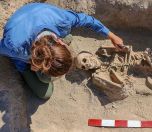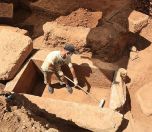Click to read the article in Turkish
Two human skeletons have been found in Küllüoba Mound in the district of Seyitgazi in Turkey's Central Anatolian province of Eskişehir.
Estimated to date back to 3,000 B.C., the skeletons were discovered during the archeological excavations continuing in the region for 23 years.
The researchers believe that one of the skeletons belongs to a 13-14-year-old girl and the other one to a man presumably aged between 35 and 40. There is also a scar on the skull of the girl.
'We don't know the exact extent of the cemetery'
As reported by Mezopotamya Agency, Assoc. Prof. Dr. Murat Türkteki, the Küllüoba Archeological Site Director and a faculty member from the Bilecik Şeyh Edebali University Department of Archeology, has stated that two people have been found in the same sarcophagus, suggesting that they were buried together as they died for the same reason.
Türkteki has shared the following information in brief:
"We have identified the cemetery area and we are continuing the excavation works. We can say that the cemetery dates back to 3,000 B.C.
"Stone-cist graves, mud-cist graves, square-cist graves have been identified in this area. We cannot yet know where the cemetery area extends.
"There is a double burial inside the same stone-cist grave. It will be analyzed, but the fact that two people are in the same grave might be indirectly indicating a line of descent between the two.
"A death by injury is also the case here. We will, therefore, continue our analyses for that." (EKN/SD)






